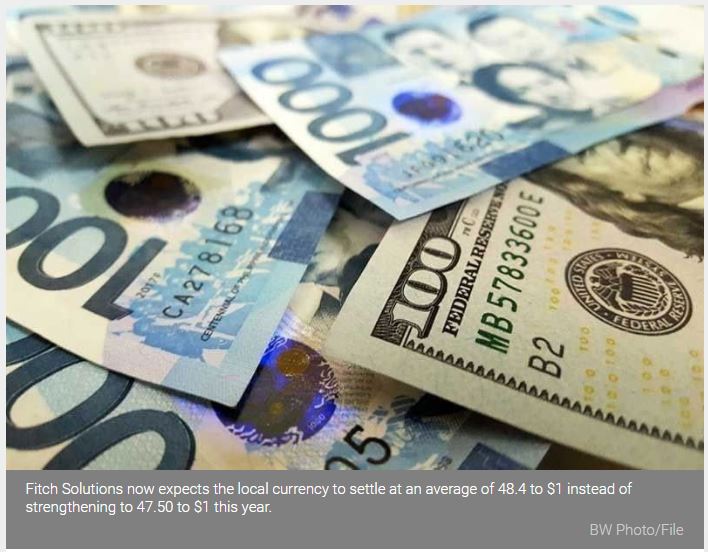Philippines: Peso may weaken as virus spreads
MANILA, Philippines — The peso may weaken against the dollar over the next two years as the Philippines continues to struggle in containing the still raging pandemic, according to Fitch Solutions Country Risk & Industry Research.
Fitch Solutions now expects the local currency to settle at an average of 48.4 to $1 instead of strengthening to 47.50 to $1 this year.
“We at Fitch Solutions forecast the Philippine peso to remain on a weak footing over the short term as volatility picks up, but fundamentals prove supportive,” it said.
The peso emerged as one of the best performing currencies in the region in 2020, gaining over five percent to close at 48.023 to $1 from 50.635 to $1 in end-2019, primarily due to the absence of demand for the dollar caused by the slump in global trade.
Given the recent surge in COVID-19 cases threatening the country’s near-term economic recovery, Fitch Solutions said the 48 to $1 is the new resistance instead of support level.
The government has banned cross-border travel and all mass gatherings in the National Capital Region (NCR) and the surrounding provinces of Bulacan, Cavite, Laguna and Rizal until April 4 as COVID-19 cases breached the 660,000 level with almost 13,000 deaths.
The research arm of the Fitch Group said the Philippine Stock Exchange (PSE) index has lost around eight percent since the start of the year as the pandemic uncertainty continues to dampen investor appetite for Philippine assets.
“Another lockdown could see foreign investor sentiment around the peso weaken even further,” Fitch Solutions said.
Fitch Solution has also raised its oil price outlook to an average of $63 per barrel instead of $58 per barrel this year, aggravating global inflationary pressures and raising the Philippines’ import bill.
It said the Philippines’ current account would remain in surplus, further bolstering the gross international reserves (GIR), which hit an all-time high of $110.1 billion in end-2020.
For 2022, Fitch Solutions expects the peso to depreciate further and average 50 to $1 on the back of strong credit growth, loose fiscal stance, and the reversal of the current account position to a deficit.
“In the long run, we maintain our forecast for the peso to weaken to an average 50 to $1 owing to a widening current account deficit and stimulatory fiscal policy,” Fitch Solutions said.
The local currency has been depreciating since February as the rise in US Treasury yields accelerated, weighing on emerging market assets.
“Investor appetite for the peso has been further dampened by rising oil prices, given the country’s net importer position, and a resurgence in COVID-19 cases in Manila in March. These headwinds are unlikely to abate in the near term, underscoring further peso depreciation,” Fitch Solutions said.
Fitch Solutions see the country bouncing back with a gross domestic product (GDP) growth of 7.6 percent this year and 6.8 percent next year after a record 9.5 percent contraction last year.
“Over the long term, we anticipate the Philippines economy to recover on the back of strong investment and an easing of domestic mobility restrictions,” it said.
However, it said the rosy outlook remains at risk given the expected slow vaccine roll out in the Philippines.
“Issues around relatively low levels of trust in vaccines and the country’s largest populous pose challenges and ultimately could see the Philippines still implementing mobility restrictions in 2022, hampering economic activity,” it said.
Source: https://www.philstar.com/business/2021/03/23/2086243/peso-may-weaken-virus-spreads


 English
English




